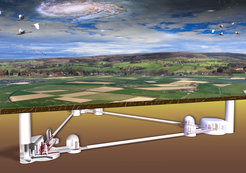Dutch-German impulse for gravitational wave research
Nikhef and Albert Einstein Institute sign cooperation agreement at the Hannover Messe
Today, Prof. Dr. Karsten Danzmann, director at the Max Planck Institute for Gravitational Physics in Hannover and director of the Institute for Gravitational Physics at Leibniz Universität Hannover (LUH) and Prof. Dr. Stan Bentvelsen, director of the National Institute for Subatomic Physics (Nationaal instituut voor subatomaire fysica/Nikhef) signed a declaration in the presence of Dutch Prime Minister Mark Rutte to strengthen scientific and technological cooperation in the area of gravitational wave research. The agreement will define the collaboration of Dutch and German researchers in the development of the Einstein Telescope (ET), a new (third generation) detector for gravitational waves. The signing took place during the Hannover Messe 2016, the world’s largest technology trade fair.
“This is an important milestone on the way to the Einstein Telescope”, says Karsten Danzmann. “Scientists from Germany and the Netherlands will work together closely in the coming years to develop this European project. The first detection of gravitational waves has just shown how successfully we can do this.”
The Einstein Telescope ET

ET is a third generation gravitational wave detector that will be about 30 times as sensitive as the existing instruments. It will deliver astronomy that allows a much more detailed and precise observation of the Universe. ET will open regions of the Universe which are hidden to us today.
Hannover is leading in the field of gravitational wave detection
In September 2015 the US LIGO detectors observed the first gravitational wave, with researchers at the Max Planck Institute for Gravitational Physics (Albert Einstein Institute; AEI), the Leibniz Universität Hannover (LUH) and the German-British GEO600 gravitational wave detector making crucial contributions to the discovery. After a rigorous validation process the scientists concluded that the detected gravitational waves were produced during the final fraction of a second of the merger of two black holes to produce a single, more massive spinning black hole. The results were published in February 2016. Many of the core technologies enabling the detection were developed and tested in the GEO collaboration. Researchers at the AEI also made crucial contributions in other key areas, developing efficient data analysis methods running on powerful computer clusters and highly accurate waveform models to detect the signal and infer astrophysical information from it.












